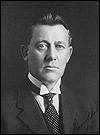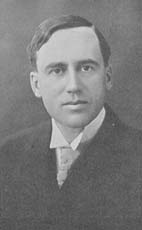|
Thunder Creek (1912–1938 Electoral District)
Thunder Creek is a former provincial electoral district for the Legislative Assembly of the province of Saskatchewan, Canada. This district was created before the 3rd Saskatchewan general election in 1912. The constituency was dissolved and combined with the Arm River, Morse and Lumsden districts before the 9th Saskatchewan general election in 1938. This district was revived for the 18th Saskatchewan general election in 1975. Members of the Legislative Assembly Election results , - , Conservative , Andrew Dunn Gallaugher , align="right", 1,015 , align="right", 44.93% , align="right", – , - bgcolor="white" !align="left" colspan=3, Total !align="right", 2,259 !align="right", 100.00% !align="right", , - , style="width: 130px", Conservative , Andrew Dunn Gallaugher , align="right", 2,165 , align="right", 45.72% , align="right", +0.79 , - bgcolor="white" !align="left" colspan=3, Total !align="right", 4,735 !align="right", 100.00% !align="right", , - , Con ... [...More Info...] [...Related Items...] OR: [Wikipedia] [Google] [Baidu] |
List Of Saskatchewan Provincial Electoral Districts
Current electoral districts * Athabasca (1934) * Arm River (2016) * Batoche (2003) * Biggar-Sask Valley (2016) * Cannington (1995) * Canora-Pelly (1995) * Carrot River Valley (1995) * Cumberland (1975) * Cut Knife-Turtleford (2003) * Cypress Hills (1995) * Estevan (1975) * Humboldt-Watrous (2016) * Indian Head-Milestone (1995) * Kelvington-Wadena (1975) * Kindersley (1975) * Last Mountain-Touchwood (1975) * Lloydminster (1995) * Lumsden-Morse (2016) * Martensville-Warman (2016) * Meadow Lake (1934) * Melfort (2003) * Melville-Saltcoats (2003) * Moose Jaw North (1995) * Moose Jaw Wakamow (1991) * Moosomin (1905) * Prince Albert Carlton (1991) * Prince Albert Northcote (1991) * Regina Coronation Park (1995) * Regina Douglas Park (2003) * Regina Elphinstone-Centre (2003) * Regina Gardiner Park (2016) * Regina Lakeview (1995) * Regina Northeast (1995) * Regina Pasqua (2016) * Regina Rochdale (2016) * Regina Rosemont (2003) * Regina University (2016) * Reg ... [...More Info...] [...Related Items...] OR: [Wikipedia] [Google] [Baidu] |
Progressive Party Of Saskatchewan
The Progressive Party of Saskatchewan was a provincial section of the Progressive Party of Canada and was active from the 1920s to the mid-1930s. The Progressives were an agrarian, social democratic political movement. It was originally dedicated to political and economic reform; it also challenged economic policies that favoured the financial and industrial interests in Central Canada over agrarian (and, to some extent, labour) interests. Like its federal counterpart it favoured free trade over protectionism. The Progressive movement in Saskatchewan Despite the dominance of agriculture in Saskatchewan, the Progressive Party of Saskatchewan was never able to match the success it and the United Farmers movement had in other provinces such as Alberta, where the United Farmers of Alberta took power, Manitoba, where the Progressive Party of Manitoba was able to form government, or even Ontario, where the United Farmers of Ontario took power in 1919. This was largely because while in ... [...More Info...] [...Related Items...] OR: [Wikipedia] [Google] [Baidu] |
List Of Political Parties In Saskatchewan
Parties represented in the Legislative Assembly Other registered parties Historical parties * Aboriginal People's Party * Alliance * Co-operative Commonwealth Federation * Communist Party * Democratic Action Party * Economic Group * First Nations Party * New Green Alliance * Labor-Progressive Party ( Communist) * Marijuana Party * Nonpartisan League * Progressive Party * Provincial Rights Party * Social Credit Party * Unity ( Communist) * Unionest Party * Western Canada Concept Party * Western Independence Party Unregistered partiesPrairie Freedom Alliance Party See also *Elections Saskatchewan *List of Saskatchewan general elections References External links Registered Political Parties (As of September 23, 2011) {{Lists of political parties in Canada Parties Saskatchewan Saskatchewan ( ; ) is a province in western Canada, bordered on the west by Alberta, on the north by the Northwest Territories, on the east by Manitoba, to the northeast by Nunavut, an ... [...More Info...] [...Related Items...] OR: [Wikipedia] [Google] [Baidu] |
List Of Saskatchewan General Elections
This article provides a summary of results for the general elections to the Canadian province of Saskatchewan's unicameral legislative body, the Legislative Assembly of Saskatchewan. The number of seats has varied over time, from 25 for the first election in 1905, to a high of 66 for the 1991 election. There are currently 61 seats. The chart on the upper right shows the information graphically, with the most recent elections on the right. It shows the popularity of the Liberal Party (red) before World War II, and the subsequent rise of the Co-operative Commonwealth Federation – succeeded by the New Democratic Party (orange). The successes and failures by the Conservatives (blue) and the recent arrival of the Saskatchewan Party (green) can also be seen. Summary of results The table below shows the total number of seats won by the major political parties at each election. The winning party's total is shown in bold. Full details on any election are linked via the year of the ... [...More Info...] [...Related Items...] OR: [Wikipedia] [Google] [Baidu] |
Electoral District (Canada)
An electoral district in Canada is a geographical constituency upon which Canada's representative democracy is based. It is officially known in Canadian French as a ''circonscription'' but frequently called a ''comté'' (county). In English it is also colloquially and more commonly known as a Riding (division), riding or constituency. Each federal electoral district returns one Member of Parliament (Canada), Member of Parliament (MP) to the House of Commons of Canada; each Provinces and territories of Canada, provincial or territorial electoral district returns one representative—called, depending on the province or territory, Member of the Legislative Assembly (MLA), National Assembly of Quebec, Member of the National Assembly (MNA), Member of Provincial Parliament (Ontario), Member of Provincial Parliament (MPP) or Newfoundland and Labrador House of Assembly, Member of the House of Assembly (MHA)—to the provincial or territorial legislature. Since 2015, there have been 338 ... [...More Info...] [...Related Items...] OR: [Wikipedia] [Google] [Baidu] |
Saskatchewan New Democratic Party
The Saskatchewan New Democratic Party (NDP) is a social-democratic political party in the Canadian province of Saskatchewan. It currently forms the official opposition, but has been a dominant force in Saskatchewan politics since the 1940s. The party is the successor to the Saskatchewan section of the Co-operative Commonwealth Federation (CCF), and is affiliated with the federal New Democratic Party. History Precursors The origins of the party began as early as 1902. In that year a group of farmers created the Territorial Grain Growers' Association. The objective of this group was to lobby for farmer's rights with the grain trade and the railways. The name was changed to the Saskatchewan Grain Growers' Association (SGGA) when Saskatchewan became a province in 1905. In 1921 a left-wing splinter group left the SGGA to form the ''Farmer's Union''. However, the two groups reconciled in 1926 and reformed as the United Farmers of Canada (Saskatchewan Section) (UFC). The first l ... [...More Info...] [...Related Items...] OR: [Wikipedia] [Google] [Baidu] |
1934 Saskatchewan General Election
The 1934 Saskatchewan general election was held on June 19, 1934, to elect members of the Legislative Assembly of Saskatchewan. The Liberal Party of Saskatchewan, Liberal Party of former List of premiers of Saskatchewan, Premier James Garfield Gardiner, James Gardiner was returned to power with a large majority – 50 of the 55 seats in the legislature – after the four year Conservative minority government interlude. After forming a coalition government to oust the Liberals from power after the 1929 Saskatchewan general election, 1929 election, James Thomas Milton Anderson, James T.M. Anderson's Progressive Conservative Party of Saskatchewan, Conservative government had tried to use anti-Roman Catholic Archdiocese of Regina, Catholic and anti-Fransaskois, French Canadian feeling in the province to win support. The Conservatives also had the support of the Ku Klux Klan in Canada, Ku Klux Klan, which was a significant force in the province at the time.Weedmark, Kevin"When the KKK ... [...More Info...] [...Related Items...] OR: [Wikipedia] [Google] [Baidu] |
1929 Saskatchewan General Election
The 1929 Saskatchewan general election was held on June 6, 1929 to elect members of the Legislative Assembly of Saskatchewan. As a result of corruption scandals, the Liberal Party of Premier James Gardiner lost a significant share of its popular vote, but more important, lost twenty-two of the seats it had won in the 1925 election. While the Liberals held the largest number of seats in the legislature, they had only a minority. Gardiner tried to continue as a minority government, but was quickly defeated in a Motion of No Confidence, and resigned as premier. The Conservative Party of James T.M. Anderson increased its representation in the legislature from three to twenty four seats. Following Gardiner's resignation, Anderson was able to form a coalition government with the support of the Progressive Party and some independents. The Progressives had lost a large part of the popular vote it had won in 1925, but managed to retain five of the six seats it had won previously. Resu ... [...More Info...] [...Related Items...] OR: [Wikipedia] [Google] [Baidu] |
1925 Saskatchewan General Election
The 1925 Saskatchewan general election was held on June 2, 1925 to elect members of the Legislative Assembly of Saskatchewan. The Liberal Party of Saskatchewan – under its new leader, Charles A. Dunning – won its sixth consecutive victory, and continued to dominate the legislature. The Progressive Party of Saskatchewan increased its share of the vote from 7.5% to over 23%, but failed to add to its six member caucus. The Conservative Party of James Anderson also increased its vote by over 14%, but only increased its representation in the legislature from two to three members. The increase in the Progressive and Conservative vote came from voters who had supported independent candidates in the 1921 election. Results Note:* Party did not nominate candidates in previous election. Percentages Members elected For complete electoral history, see individual districts July 21, 1925 For complete electoral history, see individual districts See also * List of Saskatchewan po ... [...More Info...] [...Related Items...] OR: [Wikipedia] [Google] [Baidu] |
1921 Saskatchewan General Election
The 1921 Saskatchewan general election was held on June 9, 1921, to elect members of the Legislative Assembly of Saskatchewan. The Liberal Party of Saskatchewan of Premier William M. Martin was re-elected – although with a diminished share of the popular vote, and a reduced caucus in the legislature. The opposition Conservative Party – led by Donald McLean – fractured: it nominated only seven candidates, and won only two seats. Its share of the popular vote fell from about 36% to less than 4%. It appears that many Conservatives ran as independents or Independent Conservatives. These two groups won over 29% of the vote, and voters elected a total of eight Members of the Legislative Assembly (MLAs) under these banners. The Progressive Party of Saskatchewan made its first appearance, winning six of the seven ridings that it contested. Results Note: * Party did not nominate candidates in previous election. Percentages Members of the Legislative Assembly elected For c ... [...More Info...] [...Related Items...] OR: [Wikipedia] [Google] [Baidu] |
Alexander Beaudreau
Alexander is a male given name. The most prominent bearer of the name is Alexander the Great, the king of the Ancient Greek kingdom of Macedonia who created one of the largest empires in ancient history. Variants listed here are Aleksandar, Aleksander and Aleksandr. Related names and diminutives include Iskandar, Alec, Alek, Alex, Alexandre, Aleks, Aleksa and Sander; feminine forms include Alexandra, Alexandria, and Sasha. Etymology The name ''Alexander'' originates from the (; 'defending men' or 'protector of men'). It is a compound of the verb (; 'to ward off, avert, defend') and the noun (, genitive: , ; meaning 'man'). It is an example of the widespread motif of Greek names expressing "battle-prowess", in this case the ability to withstand or push back an enemy battle line. The earliest attested form of the name, is the Mycenaean Greek feminine anthroponym , , (/Alexandra/), written in the Linear B syllabic script. Alaksandu, alternatively called ''Alakasandu'' ... [...More Info...] [...Related Items...] OR: [Wikipedia] [Google] [Baidu] |




